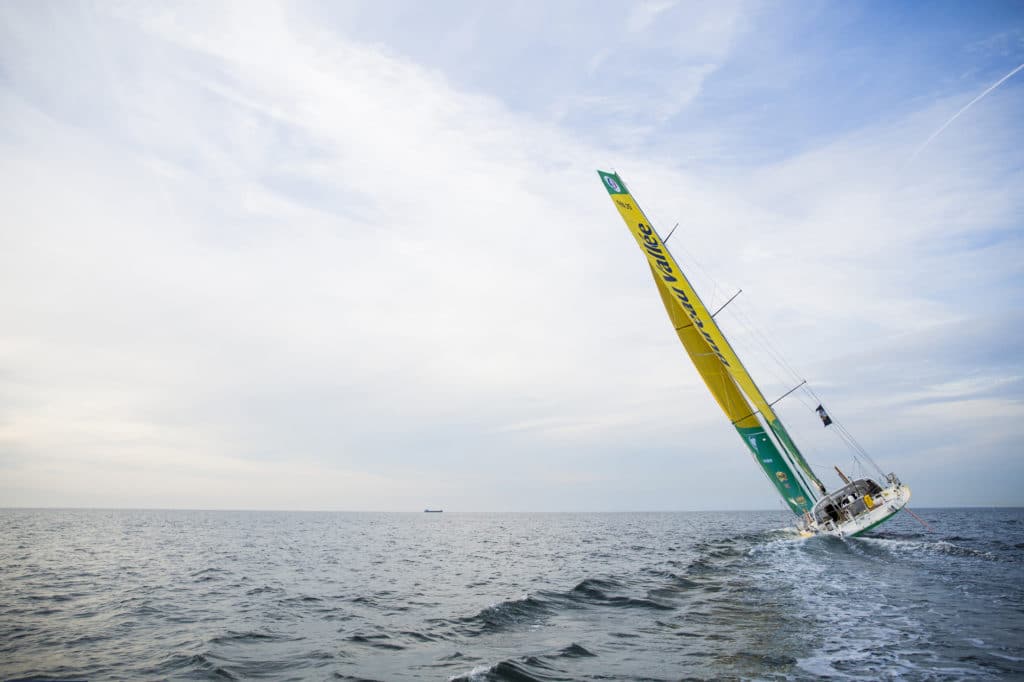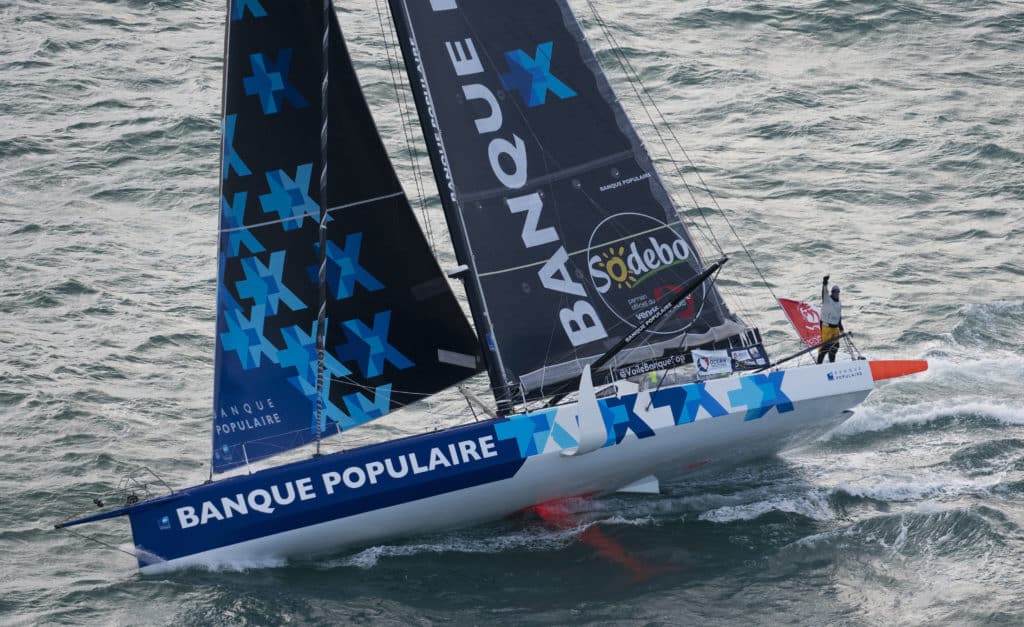
Louis Burton secured seventh place in the Vendée Globe this Thursday morning when he crossed the finish line off Les Sables d’Olonne at 07hrs, 47 mins, 49 seconds. For the young solo skipper who lives in Saint Malo, completing the legendary solo non stop round the world race today represents a major triumph.
‘Get Lucky’ by the Grammy Award winning French dance act Daft Punk was the booming soundtrack to his morning arrival back at the race pontoon in Port Olona. No musical backing to any of the finishes so far in this eighth edition has been more appropriate. Burton did get lucky with a succession of prolonged, beneficial weather systems during his first time in the Southern Ocean and experienced neither big storms nor prolonged calms. But his result is equally the product of steady consistency aboard a boat he knows intimately, that he has had for six years and on which he has completed all of the major French classic ocean races finally including the Vendée Globe.
At 31 years of age Burton, who was the youngest skipper to start the last Vendée Globe, sailed a mature and smart race and his team built strength and reliability into the Farr design and have been rewarded today. His elapsed time is 87 days 19 hrs, 45 mins, 49 secs. He sailed 27,477 miles at an average speed of 13 knots.
Seventh in this epic Vendée Globe is his swansong with a boat he loves. A clear signal of his aspirations to finish on the podium of the next edition of the Vendée Globe is that his team have already taken delivery of Armel Le Cléac’h’s foiling VPLP-Verdier Banque Populaire VIII, the outright winner of this race. Not only does Burton realise an excellent overall position in the fleet of 29 starters on an ‘older’ 2008 generation boat, but he finally lays to rest memories of his all-too-short 2012-2013 attempt when he was forced to retire after damaging his rigging in a collision with a trawler. The race of the 27 year old ended prematurely, on only the fourth day.
Burton’s seventh place comes as the hard earned result of a measured, regular high average paced race around the world by a partnership between skipper and boat that dates back to 2010. No other solo skipper among the 29 who started from Les Sables d’Olonne on November 6th has raced his boat for longer. It is the first full circumnavigation for the IMOCA which was built and launched as Jérémie Beyou’s Delta Dore but which never finished an IMOCA ocean race before being taken on by Burton and his loyal sponsors, a giant French office furniture and supplies company which has nearly 300 depots.
All of the boats which are placed above Burton have a greater performance potential. The only IMOCA of the same vintage is Jean Le Cam’s Finistère Mer Vent, which started life as Michel Desjoyeaux’s winning Foncia, a close Farr designed sister to Burton’s Bureau Vallée, which finished one place ahead this time. The skipper who grew up in Paris and has a Welsh father finishes with the third non-foiling IMOCA. According to Servane Escoffier, who co-manages her partner’s project, the only structural changes have been to remove the original moustache spray rails and build in additional strength and structure. Last winter a substantial sliding coachroof was fitted to improve protection. The keel was replaced and a full new electronics system and wiring change made for this race. Burton sailed many training miles solo prior to his Route du Rhum and before his 2012-13 Vendée Globe. After racing the 2009 Route du Rhum in Class 40 in Bureau Vallée colours, Burton and his brother Nelson debuted in the IMOCA class in the 2011 Transat Jacques Vabre. A dream debut, staying in the top three early in the passage from Le Havre to Puerto Limon, Costa Rica, saw them finish seventh. His first solo race was the B2B return back across the Atlantic in which he finished eighth.
Louis Burton’s seventh place finish in the Vendée Globe is underpinned by durability, reliability and knowledge of his boat backed up by sailing fast but within his limits in the south. Since stepping clear of the chasing peloton just after the Cape of Good Hope, Burton has raced very much on his own. At the finish line today, Nandor Fa on Spirit of Hungary is about one week behind, while Jean La Cam finished one week ahead of him.
He was unfortunate to lose touch with the leading group on the initial descent of the Atlantic and was then slowed by with a posse of eight or ten closely matched soloists when South Atlantic high moved south and east with them. The leaders had jumped on successive low pressure train rides east while Burton was left to lead the chasing group. In the Indian Ocean especially he hooked on to the leading edge of a low pressure system which worked for more than two weeks for him. Once in the top ten he then outlasted the successive retirals in front of him of Sébastien Josse, Thomas Ruyant and Paul Meilhat.

SAILING – VENDEE GLOBE 2017 – BANQUE POPULAIRE VG FINISH
Louis Burton’s Vendée Globe
Louis Burton started steadily, taking time to find his race rhythm. Mid-fleet at Cape Finisterre he made the same early tactical error as Alex Thomson, routing east towards the Portuguese coast and paying the price by losing two places to 18th. But as the fast trade wind sailing kicked in, Burton showed his pace and mettle gaining at the Canary Islands. By the Cape Verde Islands, Bureau Vallée was racing closely with Bertrand de Broc before he had to retire. The leading group had a relatively easy Doldrums crossing but Burton and his nearest rivals were slower on approach. By Rio on the southbound descent he was 11th but 550 miles behind Thomas Ruyant.
Thereafter, their passage was slower as they tried to exit the South Atlantic high pressure system. But by staying east of the group Burton found a narrow corridor of breeze to wriggle down which was enough to give him a little gain on the acceleration to the longitude of the Cape of Good Hope. Here he was 220 miles ahead of the next skipper Kojiro Shiraishi, the Japanese skipper on the similar Farr designed ex-Hugo Boss. He rose one place to tenth on the distressing, unfortunate demise of Kito de Pavant’s Bastide-Otio west of the Kerguelen Islands. By Campbell Island he was eighth and it was on Christmas Eve he took over seventh place which he has never been challenged for since. He passed Cape Horn on January 4th and enjoyed a relatively direct initial climb of the South Atlantic, one of the few boats to pass west of the Falklands and cut miles.
Louis Burton suffered successive small problems, his most significant being a fight with his autopilots. On the third day of racing he fixed ballast and hydro-generator problems, but nothing serious. In the third week of racing he had to slow to make starboard rudder head repairs. They had been making a noise since the start after a collision with a UFO in the first 24h of racing. In the fourth week the autopilot problems peaked. He admitted he was uncertain if they were linked to wind instruments or compass. He suffered a diesel spillage and slipped bruising his elbow and knee. In the second month, around Day 40, he had laminate repairs to do, as the ballast system seemed to be weakened. His port daggerboard housing also weakened and he recalled a slight ingress of water. He also reported two broken stanchions. Twice he was fastest in the fleet, setting his personal best record in the race of 447 miles on 10th December.
Read more about: Armel Le Cleac’h Victory | Record Setting Finish |









